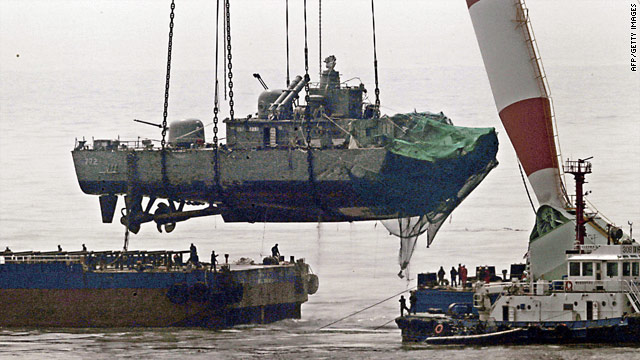S. Korean president vows action over sinking of warship

(CNN) -- An emotional President Lee Myung-bak vowed Monday to find out why a South Korean naval ship sank and to "deal resolutely" with whatever or whomever caused the sinking, the country's Yonhap news agency reported.
In a live broadcast, Lee read aloud the names of the 46 South Korean sailors lost in the March 26 sinking of the corvette Cheonan, which went down in the Yellow Sea near the North Korean border after an explosion hit the ship.
"As president, I will ascertain the cause of the Cheonan's sinking to the last detail," Lee said, according to Yonhap. "I will deal resolutely with the results and make sure such an incident does not recur."
A South Korean investigator said Friday that an "external explosion" was the most likely cause of the mysterious sinking.
 Video: Sunken ship pulled from water
Video: Sunken ship pulled from water "There is a higher possibility of an external rather than an internal explosion," said Yoon Duk-yong, the co-head of a government-appointed team to investigate the incident.
Yoon's comment was based on a preliminary investigation of the stern wreckage. He added, however, that it was necessary "to make a detailed analysis, leaving all possibilities open."
The Cheonan's stern section, where the missing sailors were believed to have been trapped, was raised from the Yellow Sea bottom Thursday. The bow section is yet to be salvaged, and Yonhap said efforts to do that were being hampered by strong currents and bad weather in the area.
Of the Cheonan's 104-man crew, 58 men were rescued from the sea on the night of the explosion. Thirty-eight bodies have so far been recovered; eight remain missing.
South Korean Defense Minister Kim Tae-young on Friday called the sinking "a grave national security incident."
While Seoul has avoided blaming North Korea, Kim has said that a sea mine or torpedo appear the most likely causes. The media has been rife with speculation -- theories aired range from an internal boiler explosion to a North Korean naval special forces attack.
Yonhap said on Saturday, North Korea's military denied any involvement, accusing the South of spreading false rumors.
South Korean Foreign Minister Yu Myung-hwan said Sunday that South Korea might take the case to the U.N. Security Council if North Korea is found to be responsible, Yonhap reported.
Lee's aides said once the cause is determined, Lee will again speak to his countrymen, possibly in a "special address to the people," according to Yonhap.
The news agency reported that after reading the names of the 46 lost sailors, Lee said, "If (the two Koreas) are reunited and genuine peace and prosperity comes to this land, the people will remember your sacrifice again".
"Your fatherland, which you loved, will not forget you ever."

No comments:
Post a Comment